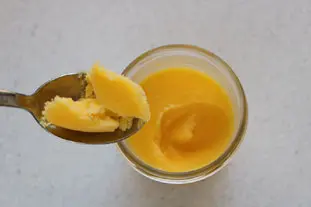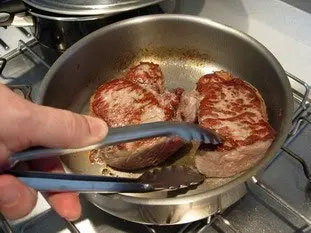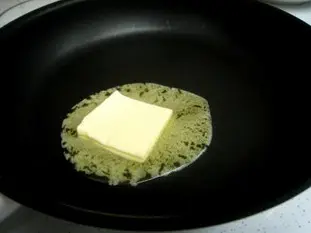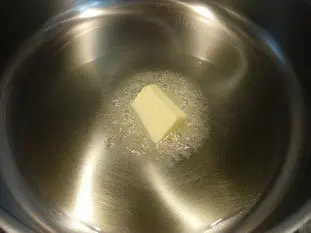Fats for cooking

If you need to fry or sear anything a frying pan or saucepan, the temperature is likely to be high.
In particular, I have cooking red meat in mind. In this case, what should fat should we use? And at what temperature?
In particular, I have cooking red meat in mind. In this case, what should fat should we use? And at what temperature?
20 K 5/5 (13 reviews)
Last modified on: January 23th 2018
Fats for cooking
For our red meat, let's imagine we want to fry a tournedos (let's go straight for something top-of-the-range). The same goes for this as for all other fried or seared red meat, and there's no secret: really, really hot; the meat should be seared or flash fried.
So much for the temperature, but what about the fat? For simplicity's sake, let's narrow this down to two possibilities: butter or oil.
Oil: No problem with this; the oil will take being heated to a high temperature. There's a trick to knowing when it is hot enough => it will begin to give off a light smoke. Look out for this and as soon as it happens, put your meat in the pan. Do be careful, though; you need to react quickly and not let it burn and smoke too much.
Butter: This presents more of a problem. Butter will not take high temperatures. To start with, it melts and foams, so we might go ahead and add the meat at that point. But as the temperature continues to rise, the butter will end up burning and give a very unpleasant, bitter flavour.
So, as you can see, if you want to cook at a very high temperature, it is better to use oil, as butter is unsuitable.
That's all very well, but oil doesn't taste the same as butter and doesn't give the same flavour to the meat; generally, butter makes it taste better (yes, taste also matters). So, is there really no way to fry meat in butter?
As it happens, there is – but not with normal butter. We need to use clarified butter, which is butter that has been separated off from the white milk solids, which you can see as the little bits in the photo above. These would end up burning and turning brown during frying. It is fairly simple to make and keeps very well.
There is a third way, using a mixture of the two: a little oil in the bottom and then butter added. This allows the temperature to be raised higher than for ordinary butter alone, but clarified butter is still the better option by far.
To sum up: When cooking red meat, always fry it at high temperature, and for the fat, use oil or clarified butter.
So much for the temperature, but what about the fat? For simplicity's sake, let's narrow this down to two possibilities: butter or oil.
Oil: No problem with this; the oil will take being heated to a high temperature. There's a trick to knowing when it is hot enough => it will begin to give off a light smoke. Look out for this and as soon as it happens, put your meat in the pan. Do be careful, though; you need to react quickly and not let it burn and smoke too much.

Butter: This presents more of a problem. Butter will not take high temperatures. To start with, it melts and foams, so we might go ahead and add the meat at that point. But as the temperature continues to rise, the butter will end up burning and give a very unpleasant, bitter flavour.

So, as you can see, if you want to cook at a very high temperature, it is better to use oil, as butter is unsuitable.
That's all very well, but oil doesn't taste the same as butter and doesn't give the same flavour to the meat; generally, butter makes it taste better (yes, taste also matters). So, is there really no way to fry meat in butter?

As it happens, there is – but not with normal butter. We need to use clarified butter, which is butter that has been separated off from the white milk solids, which you can see as the little bits in the photo above. These would end up burning and turning brown during frying. It is fairly simple to make and keeps very well.
There is a third way, using a mixture of the two: a little oil in the bottom and then butter added. This allows the temperature to be raised higher than for ordinary butter alone, but clarified butter is still the better option by far.

To sum up: When cooking red meat, always fry it at high temperature, and for the fat, use oil or clarified butter.
Lasts posts
The importance of sieving
In recipes that use a fine powder (flour, powdered sugar, etc.), you'll often see the advice to sift before using it. To sift is to pass the powder in question through a sieve (a very fine strainer) before incorporating it into your recipe. It's often advice, but is it really useful?September 3rd 2025928
The grease spray
As soon as you have something in a recipe that sticks to the mold, the question always arises as to how difficult it is to remove from the mold. There's nothing more frustrating than breaking your cake when unmolding it, because part of it has stuck in the mold. The classic way to avoid this is...August 26th 20254,3455
Cake moulds
When we make a cake, or a cake of the same rectangular shape, we usually take out our usual mould and tell ourselves that the recipe is anyway "for a cake", but is it really that simple?August 25th 20254,6595
Thinning out herbs
If you need to add a long-stemmed herb (tarragon, mint, verbena, thyme, etc.) to a recipe, you'll probably only need the leaves and not the stem, so you'll need to remove the leaves. Leaf removal means keeping only the beautiful leaves, and eliminating the ugly stems and leaves, but how do you do...August 8th 20252,8765
Add a bay leaf
Bay leaf: small in size, but big in flavor. You'll find it in hundreds of recipes, and it's often added to cooking meat, in a sauce or broth, usually accompanied by other herbs or products. It's a staple of Provençal, Mediterranean and Oriental cuisine, but not the only one. Usually, in a...July 31th 20252,9815
Other pages you may also like
The importance of sieving
In recipes that use a fine powder (flour, powdered sugar, etc.), you'll often see the advice to sift before using it. To sift is to pass the powder in question through a sieve (a very fine strainer) before incorporating it into your recipe. It's often advice, but is it really useful?September 3rd 2025928
The 3 secrets of Parisian flan
A flan Parisien, or boulanger, is a simple yet delicious cake. A cream, a mixture of milk, eggs and sugar, is poured into a raw pastry base and baked in the oven until the pastry and cream are cooked. This is the simplest version of the recipe, probably the original one, but nowadays the cream...July 21th 202313 K4.7
The art of the charlotte
In cooking, a charlotte is a delicious moulded dessert, with biscuits around the outside that have been soaked in a flavoured syrup, filled with a light cream or mousse. The charlotte is left to set in the fridge before being turned out and served in slices. It is very light and a lovely sweet...February 27th 201344 K4.3
85 grams of eggs?
Some time ago, I already spoke to you about the difference between baking and pastry-making, I emphasized, among other things, the precision of pastry-making which requires grams, cm, degrees and minutes. That's why, on the one hand, you have baking and cooking, where a certain tolerance is...November 26th 201854 K4.6
Parsley stems
Parsley, whether curly or flat, is a delicious ingredient in many recipes, where it is used both raw and cooked. When used raw, in a salad for example, where it always provides, alone or with other herbs, a remarkable freshness, only the leaves are kept. And when used cooked?July 28th 20253,203 13
Post a comment or question
Follow this page (as 3 people already do)
If you are interested in this page, you can "follow" it, by entering your email address here. You will then receive a notification immediately each time the page is modified or a new comment is added. Please note that you will need to confirm this following.
Note: We'll never share your e-mail address with anyone else.
Alternatively: you can subscribe to the mailing list of cooling-ez.com , you will receive a e-mail for each new recipe published on the site.








